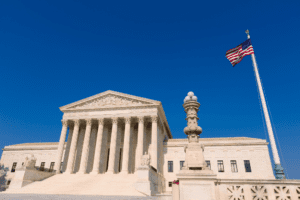 Justice Breyer continued: The Court, not an expert in history, had misread Blackstone and other sources explaining the English Bill of Rights. And that was not the Heller Court’s only questionable judgment. The majority rejected Justice Stevens’ argument that the Second Amendment’s use of the words “bear Arms” drew on an idiomatic meaning that, at the time of the founding, commonly referred to military service. 554 U. S., at 586. Linguistics experts now tell us that the majority was wrong to do so. See, e.g., Brief for Corpus Linguistics Professors and Experts as Amici Curiae (Brief for Linguistics Professors); Brief for Neal Goldfarb as Amicus Curiae; Brief for Americans Against Gun Violence as Amicus Curiae 13–15.
Justice Breyer continued: The Court, not an expert in history, had misread Blackstone and other sources explaining the English Bill of Rights. And that was not the Heller Court’s only questionable judgment. The majority rejected Justice Stevens’ argument that the Second Amendment’s use of the words “bear Arms” drew on an idiomatic meaning that, at the time of the founding, commonly referred to military service. 554 U. S., at 586. Linguistics experts now tell us that the majority was wrong to do so. See, e.g., Brief for Corpus Linguistics Professors and Experts as Amici Curiae (Brief for Linguistics Professors); Brief for Neal Goldfarb as Amicus Curiae; Brief for Americans Against Gun Violence as Amicus Curiae 13–15.
Since Heller was decided, experts have searched over 120,000 founding-era texts from between 1760 and 1799, as well as 40,000 texts from sources dating as far back as 1475, for historical uses of the phrase “bear arms,” and they concluded that the phrase was overwhelmingly used to refer to “‘war, soldiering, or other forms of armed action by a group rather than an individual.’” Brief for Linguistics Professors 11, 14; see also D. Baron, Corpus Evidence Illuminates the Meaning of Bear Arms, 46 Hastings Const. L. Q. 509, 510 (2019) (“Non-military uses of bear arms in reference to hunting or personal self-defense are not just rare, they are almost nonexistent”); id., at 510– 511 (reporting 900 instances in which “bear arms” was used to refer to military or collective use of firearms and only 7 instances that were either ambiguous or without a military connotation). These are just two examples.
Other scholars have continued to write books and articles arguing that the Court’s decision in Heller misread the text and history of the Second Amendment. See generally, e.g., M. Waldman, The Second Amendment (2014); S. Cornell, The Changing Meaning of the Right To Keep and Bear Arms: 1688–1788, in Guns in Law 20–27 (A. Sarat, L. Douglas, & M. Umphrey eds. 2019); P. Finkelman, The Living Constitution and the Second Amendment: Poor History, False Originalism, and a Very Confused Court, 37 Cardozo L. Rev. 623 (2015); D. Walker, Necessary to the Security of Free States: The Second Amendment as the Auxiliary Right of Federalism, 56 Am. J. Legal Hist. 365 (2016); W. Merkel, Heller as Hubris, and How McDonald v. City of Chicago May Well Change the Constitutional World as We Know It, 50 Santa Clara L. Rev. 1221 (2010).
Justice Breyer his own point in admitting the seven historical instances in which the phrase “bear arms” was used without a military context. More than one instance seems to be enough to support the assertion that the phrase has historically been used in recognition of an individual right. Moreover, it makes little sense that one private citizen has no right to possess a firearm but if he joins up with a group of other citizens, then the right exists. If safety is the dissent’s prime concern, there should be a greater concern for a group of armed citizens than for one armed citizen.
